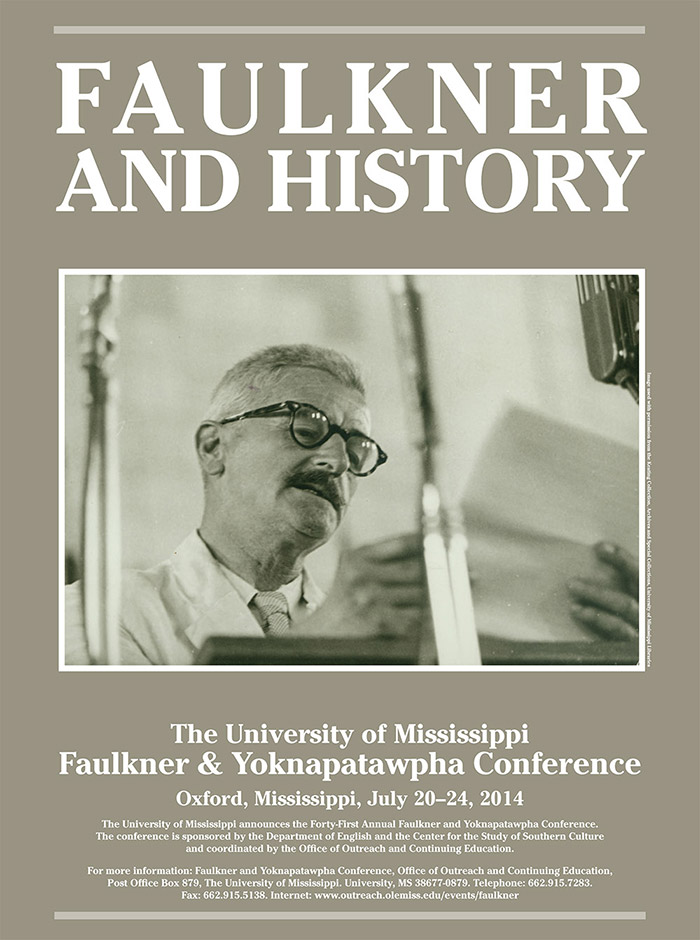
Panel. Thinking Literature and History Comparatively
Location
Nutt Auditorium
Start Date
22-7-2014 9:30 AM
Description
- William Faulkner, Lawrence Stallings, and the Chronicling of World War I / Jason Fichtel, Joliet Junior College
- Reading Faulkner and Benét: From Yoknapatawpha to Region, or How to Revisit History in the South of Europe / Esther Sánchez-Pardo, Compultense Universidad de Madrid
This paper places Faulkner’s legacy in a larger global framework in order to sketch the relationship between late modernisms and the interpretation of history, then and in the decades to come, in the context of other (non-US) national histories. For this reason my reading of Faulkner with Spanish novelist Juan Benet (1927-1993) pursues the idea of situating Faulkner in Europe and assessing the centrality of his influence on major writers and literary traditions. The comparative framework that I use in this paper will allow us to understand the particularities of Faulkner’s work as part of a broader project to essay revisionist histories employing the particular strategies of modernism as well as its impact on larger geographical areas and times. As I will attempt to show, the kinds of formal experimentation found in this tradition are deeply tied to a struggle to comprehend historical realities and their effects. - From the Mississippi to the Yangtze: Faulkner and Mo Yan's Wartime History / Christopher Rieger, Southeast Missouri State University
This paper examines some of the influences, connections, and similarities between two Nobel Prize winning authors, William Faulkner (1950) and Mo Yan (2012), and specifically their relationships to history as seen through each author’s novel of civil war: Mo Yan’s Red Sorghum (1987) and Faulkner’s The Unvanquished (1938). Set in the 1930s and 40s, Red Sorghum details life in rural Shandong province during the Japanese invasion. It depicts common people resisting an invading army portrays both absurdly and heroically, a description also apt for The Unvanquished. Both writers combine the actual and the apocryphal in order to celebrate the fighting spirit of occupied people and to elevate figures from the past to near-heroic levels. Both writers also express veiled critiques of the present, though Mo Yan is perhaps more conservative than Faulkner in his reassessment of history for reasons both aesthetic and political.
Relational Format
Conference proceeding
Recommended Citation
Fichtel, Jason; Sánchez-Pardo, Esther; and Rieger, Christopher, "Panel. Thinking Literature and History Comparatively" (2014). Faulkner and Yoknapatawpha Conference. 15.
https://egrove.olemiss.edu/fy/2014/schedule/15
COinS
Jul 22nd, 9:30 AM
Panel. Thinking Literature and History Comparatively
Nutt Auditorium
- William Faulkner, Lawrence Stallings, and the Chronicling of World War I / Jason Fichtel, Joliet Junior College
- Reading Faulkner and Benét: From Yoknapatawpha to Region, or How to Revisit History in the South of Europe / Esther Sánchez-Pardo, Compultense Universidad de Madrid
This paper places Faulkner’s legacy in a larger global framework in order to sketch the relationship between late modernisms and the interpretation of history, then and in the decades to come, in the context of other (non-US) national histories. For this reason my reading of Faulkner with Spanish novelist Juan Benet (1927-1993) pursues the idea of situating Faulkner in Europe and assessing the centrality of his influence on major writers and literary traditions. The comparative framework that I use in this paper will allow us to understand the particularities of Faulkner’s work as part of a broader project to essay revisionist histories employing the particular strategies of modernism as well as its impact on larger geographical areas and times. As I will attempt to show, the kinds of formal experimentation found in this tradition are deeply tied to a struggle to comprehend historical realities and their effects. - From the Mississippi to the Yangtze: Faulkner and Mo Yan's Wartime History / Christopher Rieger, Southeast Missouri State University
This paper examines some of the influences, connections, and similarities between two Nobel Prize winning authors, William Faulkner (1950) and Mo Yan (2012), and specifically their relationships to history as seen through each author’s novel of civil war: Mo Yan’s Red Sorghum (1987) and Faulkner’s The Unvanquished (1938). Set in the 1930s and 40s, Red Sorghum details life in rural Shandong province during the Japanese invasion. It depicts common people resisting an invading army portrays both absurdly and heroically, a description also apt for The Unvanquished. Both writers combine the actual and the apocryphal in order to celebrate the fighting spirit of occupied people and to elevate figures from the past to near-heroic levels. Both writers also express veiled critiques of the present, though Mo Yan is perhaps more conservative than Faulkner in his reassessment of history for reasons both aesthetic and political.

